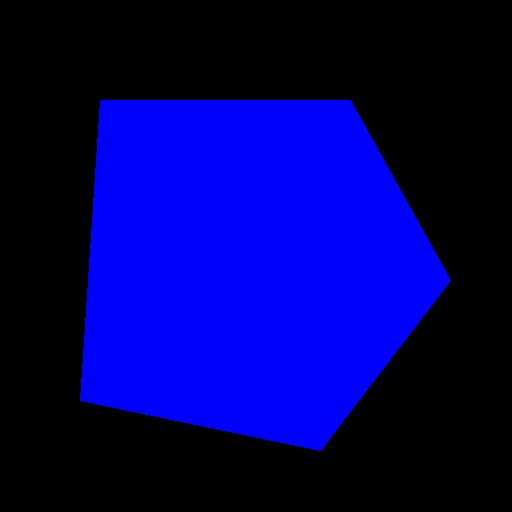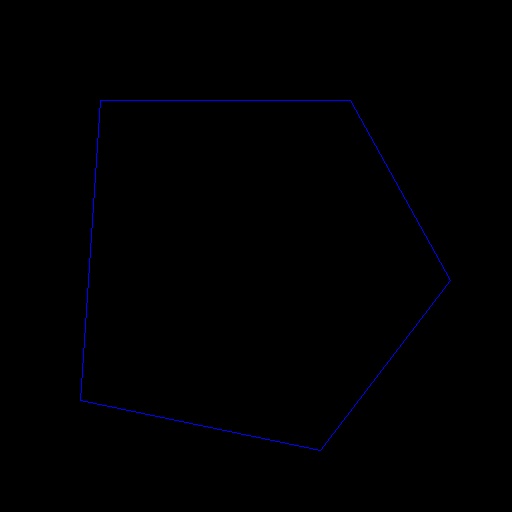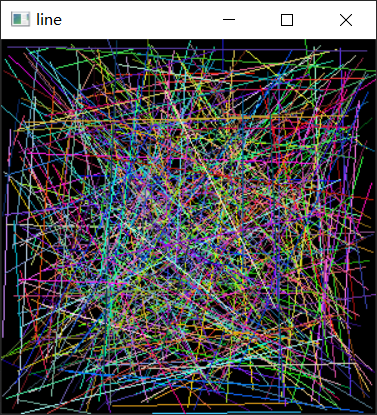绘制多边形
在使用 opencv 绘制几何图像时,除了大多数情况下绘制的简单形状,有时也需要绘制复杂的多边形形状。下面就来一起尝试如何绘制多边形形状。
首先需要了解几个 opencv 库函数。
-
cv.polylines()多边形绘制
需要传入画布、轮廓点、是否闭合、绘制颜色、线条粗细、线条类型、顶点坐标小数位。 -
cv.fillPoly()多边形填充
需要传入画布、轮廓点、填充颜色、线条类型、顶点坐标小数位。 -
drawContours()既可以填充也可以绘制多边形
需要传入画布(三通道画布才能显示轮廓)、轮廓点、绘制轮廓数(-1 表示绘制其中的所有轮廓)、颜色、轮廓粗细(-1 表示填充)。
话不多说,直接上代码:
# -*-coding:utf-8-*-
"""
File Name: image_shape_painting.py
Program IDE: PyCharm
Date: 21:12
Create File By Author: Hong
"""
import cv2 as cv
import numpy as np
def polygon_drawing():
canvas = np.zeros((512, 512, 3), dtype=np.uint8)
# 定义多边形的顶点
pts = np.array([[100, 100], [350, 100], [450, 280], [320, 450], [80, 400]], dtype=np.int32)
# 多边形绘制
# cv.polylines(canvas, [pts], True, (0, 0, 255), 2, 8, 0)
# 多边形填充
# cv.fillPoly(canvas, [pts], (255, 0, 255), 8, 0)
# 既可以填充也可以绘制形状, thickness为时绘制形状,-1时填充形状
# 可以添加多个轮廓,用,号隔开,比如[pts1, pts2, ...]
cv.drawContours(canvas, [pts], -1, (255, 0, 0), thickness=-1)
cv.imshow('polyline', canvas)
cv.waitKey(0)
cv.destroyAllWindows()
if __name__ == '__main__':
polygon_drawing()
结果展示:


随机颜色和随机数
在 opencv 中,有时需要随机的地使用一些颜色而不是固定的给出某种颜色,这个时候就需要使用随机数的方式来设置随机颜色。
主要用到的是 numpy 中的随机数函数,先介绍几种 np 中的随机数函数。
-
np.random.randn()函数np.random.randn(d0,d1,d2……dn)
1)当函数括号内没有参数时,则返回一个浮点数;
2)当函数括号内有一个参数时,则返回秩为 1 的数组,不能表示向量和矩阵;
3)当函数括号内有两个及以上参数时,则返回对应维度的数组,能表示向量或矩阵;
4)np.random.standard_normal()函数与np.random.randn()类似,但是np.random.standard_normal()的输入参数为元组(tuple);
5)np.random.randn()的输入通常为整数,但是如果为浮点数,则会自动直接截断转换为整数;
6)通过该函数可以返回一个或一组服从标准正态分布的随机样本值。 -
np.random.rand()函数np.random.rand(d0,d1,d2……dn)
注:使用方法与np.random.randn()函数相同。
1)通过本函数可以返回一个或一组服从 “0~1”均匀分布 的随机样本值。随机样本取值范围是[0,1),不包括 1。 -
np.random.randint()函数
numpy.random.randint(low, high=None, size=None, dtype=’l’)
输入:
low——为最小值
high——为最大值
size——为数组维度大小
dtype——为数据类型,默认的数据类型是np.int
返回值:
返回随机整数或整型数组,范围区间为[low,high),包含 low,不包含 high;high 没有填写时,默认生成随机数的范围是[0,low)
在随机颜色的实现中用到的是第三种函数,具体代码如下:
"""
File Name: image_shape_painting.py
Program IDE: PyCharm
Date: 21:12
Create File By Author: Hong
"""
import cv2 as cv
import numpy as np
def random_color():
img = np.zeros((300, 300, 3), dtype=np.uint8)
cv.imshow('img', img)
while True:
# 设置随机位置
xx = np.random.randint(0, 300, 2, dtype=np.int32)
yy = np.random.randint(0, 300, 2, dtype=np.int32)
# 设置随机颜色,可以用于目标检测画不同目标边界框的随机颜色
bgr = np.random.randint(0, 255, 3, dtype=np.int32)
print(bgr[0], bgr[1], bgr[2])
# 画直线,将每个bgr分量int转换以下,不然被认为不是数字,出错。
cv.line(img, (xx[0], yy[0]), (xx[1], yy[1]), (int(bgr[0]), int(bgr[1]), int(bgr[2])), 1, 8, 0)
cv.imshow('line', img)
c = cv.waitKey(1)
if c == 27:
break
cv.destroyAllWindows()
if __name__ == '__main__':
random_color()
结果展示:

更多计算机视觉内容,请关注微信公众号 “AI 与计算机视觉”。